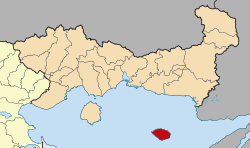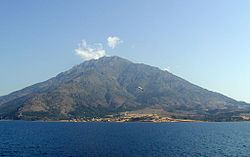- Samothrace
-
Samothrace
Σαμοθράκη
Kamariotissa, the main port of SamothraceLocation Coordinates 40°29′N 25°31′E / 40.483°N 25.517°ECoordinates: 40°29′N 25°31′E / 40.483°N 25.517°E Government Country: Greece Region: East Macedonia and Thrace Regional unit: Evros Population statistics (as of 2001) Municipality - Population: 2,723 - Area: 178.0 km2 (69 sq mi) - Density: 15 /km2 (40 /sq mi) Other Time zone: EET/EEST (UTC+2/3) Elevation (min-max): 0 - 1,611 m (0 - 5285 ft) Postal: 680 02 Telephone: 25510 Auto: ΕΒ Website www.samothraki.gr Samothrace (also Samothraki) (Greek: Σαμοθράκη, [samoˈθraci]) is a Greek island in the northern Aegean Sea. It is a self-governing municipality within the Evros peripheral unit of Thrace. The island is 17 km (11 mi) long and is 178 km2 (69 sq mi) in size and has a population of 2,723 (2001 census). Its main industries are fishing and tourism. Resources on the island includes granite and basalt. Samothrace is one of the most rugged Greek islands, with Mt. Fengari rising to 1,611 m.
Contents
History
Antiquity
Samothrace was not a state of any political significance in ancient Greece, since it has no natural harbour and most of the island is too mountainous for cultivation: Mount Fengari (Mount Moon) rises to 1,611 m (5,285 ft). It was, however, the home of the Sanctuary of the Great Gods, site of important Hellenic and pre-Hellenic religious ceremonies. Among those who visited this shrine to be initiated into the island cult were King Lysander of Sparta, Philip II of Macedon and Cornelius Piso, father-in-law of Julius Caesar.
The ancient city, the ruins of which are called Palaeopoli ("old city"), was situated on the north coast. Considerable remains still exist of the ancient walls, which were built in massive Cyclopean style, as well as of the Sanctuary of the Great Gods, where mysterious rites took place which were open to both slaves and free people (similar to the Eleusinian Mysteries).
The traditional account from antiquity is that Samothrace was first inhabited by Pelasgians and Carians, and later Thracians. At the end of the 8th century BC the island was colonised by Greeks from Samos, from which the name Samos of Thrace, that later became Samothrace; although Strabo denies this. The archaeological evidence suggests that Greek settlement was in the sixth century BC.
The Persians occupied Samothrace in 508 BC, it later passed under Athenian control, and was a member of the Delian League in the 5th century BC. It was subjected by Philip II, and from then till 168 BC it was under Macedonian suzerainity. With the battle of Pydna Samothrace became independent, a condition that ended when Vespasian absorbed the island in the Roman Empire in 70 AD.
The Book of Acts in the Christian Bible records that the Apostle Paul, on his second missionary journey outside of Palestine, sailed from Troas to Samothrace and spent one night there on his way to Macedonia. Acts 16:11
Post-Roman Era
St. Theophanes died here in 818. The Byzantines ruled till 1204, when Venetians took their place, only to be dislodged by a Genoan family in 1355, the Gattilusi. The Ottoman Empire conquered it in 1457 and was called Turkish: Semadirek; an insurrection against them by the local population during the Greek War of Independence (1821–1831) led to the massacre of most of the population. The island returned to Greek rule in 1913 following the Balkan War. It was briefly occupied by Bulgaria during the Second World War.
Today
The modern port town of Kamariotissa is on the north-west coast and provides ferry access to and from points in northern Greece such as Alexandroupoli and Kavala. There is no commercial airport on the island. Other sites of interest on the island include the ruins of Genoese forts, the picturesque Chora (old town), and several waterfalls.
Landmarks
The island's most famous site is the Sanctuary of the Great Gods, Greek Hieron ton Megalon Theon ; the most famous artifact of which is the 2.5-metre marble statue of Nike, now known as the Winged Victory of Samothrace, dating from about 190 BC. It was discovered in pieces on the island in 1863 by the French archaeologist Charles Champoiseau, and is now - headless - in the Louvre in Paris.
Communities
- Alonia (pop. 251)
- Ano Karyotes (15)
- Ano Meria (58)
- Dafnes (11)
- Kamariotissa (969)
- Kato Karyotes (37)
- Katsampas (12)
- Lakkoma (329)
- Makrylies (9)
- Mpaxedes (0)
- Pahia Ammos
- Palaiopoli (25)
- Potamia (3)
- Profitis Ilias (214)
- Remboutsadika
- Samothrace/Samothraki (677)
- Therma (74)
- Xiropotamos (39)
Historical population
Year Island population 1981 2,871 1991 3,083 2001 2,723 See also
- Communities of the Evros prefecture
- Samothrace temple complex
- Winged Victory of Samothrace
References
- Michel Mourre, Dictionnaire Encyclopédique d'Histoire, article Samothrace, Bordas, 1996
- Marcel Dunan, Histoire Universelle, Larousse, 1960
External links
- Official Samothrace webpage (in Greek)
Articles on the Aegean Sea GeneralCountries Other Cyclades Amorgos · Anafi · Andros · Antimilos · Antiparos · Delos · Despotiko · Donoussa · Folegandros · Gyaros · Ios · Irakleia · Kardiotissa · Kea · Keros · Kimolos · Koufonisia · Kythnos · Milos · Mykonos · Nata · Naxos · Paros · Polyaigos · Rineia · Santorini · Schoinoussa · Serifopoula · Serifos · Sifnos · Sikinos · Syros · Therasia · Tinos · VousDodecanese Agathonisi · Arkoi · Armathia · Alimia · Astakida · Astypalaia · Çatalada · Chalki · Chamili · Farmakonisi · Gaidaros · Gyali · Imia/Kardak · Kalolimnos · Kalymnos · Kandelioussa · Kara Ada · Karpathos · Kasos · Kinaros · Kos · Küçük Tavşan Adası · Leros · Lipsi · Lebynthos · Nimos · Nisyros · Patmos · Pacheia · Platy · Pserimos · Rhodes · Saria · Salih Ada · Symi · Syrna · Telendos · Tilos · ZaforaNorth Aegean Agios Eustratius · Ammouliani · Ayvalık Islands · Büyük Ada · Chios · Chryse · Cunda · Foça Islands · Fournoi Korseon · Icaria · Imbros · Koukonesi · Lemnos · Lesbos · Metalik Ada · Nissiopi · Oinousses · Psara · Samiopoula · Samos · Samothrace · Tenedos · Thasos · ThymainaSaronic Sporades Adelfoi Islets · Agios Georgios Skopelou · Alonnisos · Argos Skiathou · Dasia · Erinia · Gioura · Grammeza · Kyra Panagia · Lekhoussa · Peristera · Piperi · Psathoura · Repio · Rineia Skyrou · Sarakino · Skandili · Skantzoura · Skiathos · Skopelos · Skyropoula · Skyros · Tsougria · ValaxaCretan Afendis Christos · Agia Varvara · Agioi Apostoloi · Agioi Pandes · Agioi Theodoroi · Agios Nikolaos · Anavatis · Arnaouti · Aspros Volakas · Avgo · Crete · Daskaleia · Dia · Diapori · Dionysades · Elasa · Ftena Trachylia · Glaronisi · Gramvousa · Grandes · Kalydon (Spinalonga) · Karavi · Karga · Katergo · Kavallos · Kefali · Kolokythas · Koursaroi · Kyriamadi · Lazaretta · Leon · Mavros · Mavros Volakas · Megatzedes · Mochlos · Nikolos · Palaiosouda · Peristeri · Peristerovrachoi · Petalida · Petalouda · Pontikaki · Pontikonisi · Praso Kissamou · Prosfora · Pseira · Sideros · Souda · Valenti · VryonisiOther Aegean Islands Central Aegean Sea Thracian Sea Administrative division of the East Macedonia and Thrace Region  Regional unit of EvrosRegional unit of RhodopeRegional unit of Xanthi
Regional unit of EvrosRegional unit of RhodopeRegional unit of XanthiSecond Journey of Paul the Apostle 1. Cilicia · 2. Derbe · 3. Lystra · 4. Phrygia · 5.Galatia · 6. Mysia (Alexandria Troas) · 7. Samothrace · 8. Neapolis · 9. Philippi · 9. Amphipolis · 10. Apollonia · 11. Thessalonica · 12. Beroea · 13. Athens · 14. Corinth · 15. Cenchreae · 16. Ephesus · 17. Syria · 18. Caesarea · 19. Jerusalem · 20. AntiochCategories:- Samothrace
- Municipalities of East Macedonia and Thrace
- Islands of Greece
Wikimedia Foundation. 2010.









